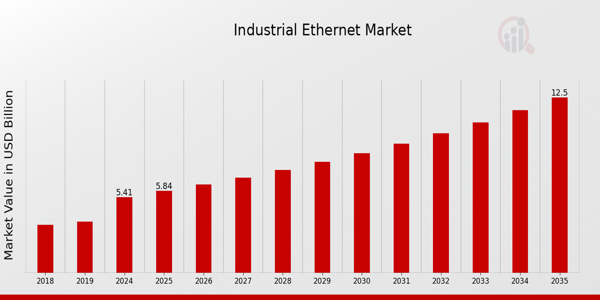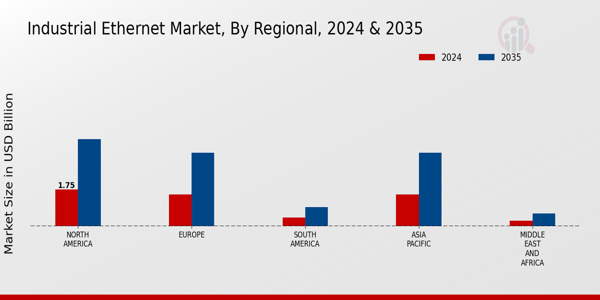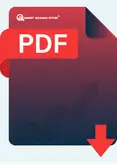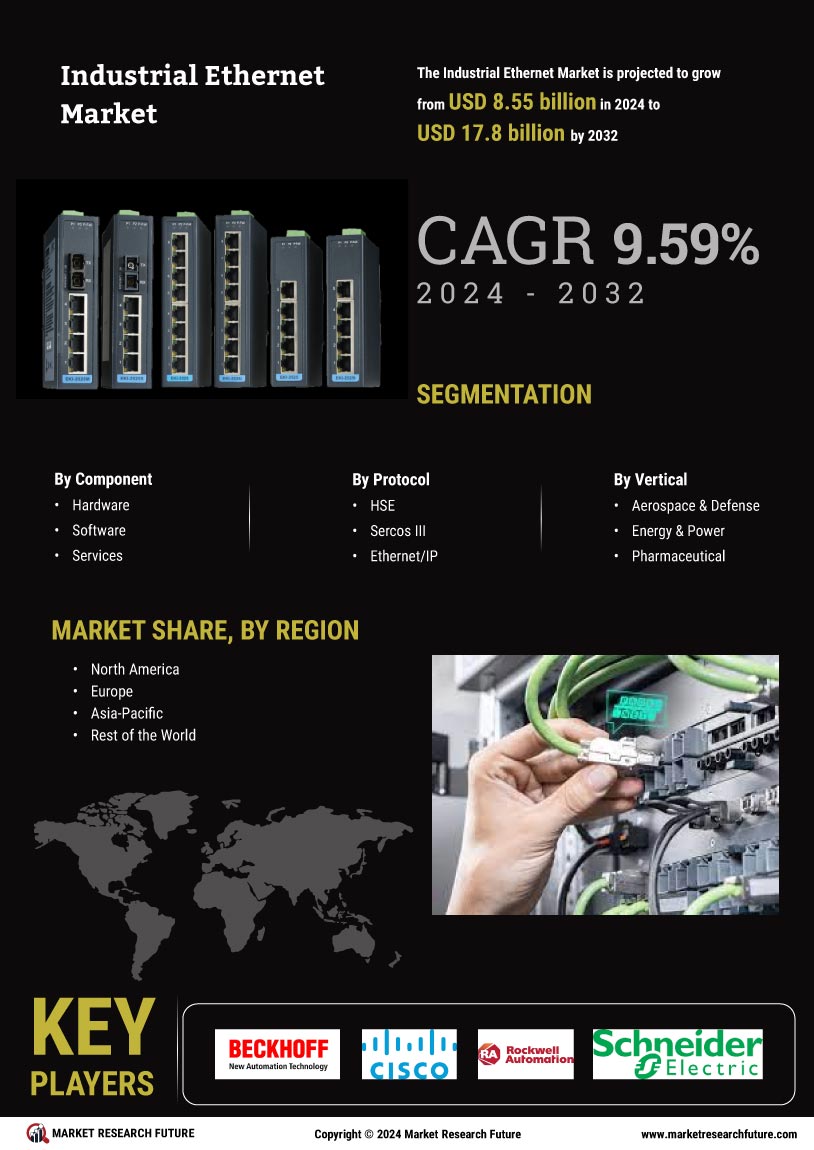Global Industrial Ethernet Market Overview
As per MRFR analysis, the Industrial Ethernet Market Size was estimated at 5.02 (USD Billion) in 2023. The Industrial Ethernet Market is expected to grow from 5.41 (USD Billion) in 2024 to 12.5 (USD Billion) by 2035. The Industrial Ethernet Market CAGR (growth rate) is expected to be around 7.91% during the forecast period (2025 - 2035)
Key Industrial Ethernet Market Trends Highlighted
The increasing need for real-time data transmission in manufacturing processes is driving the present strong momentum in the Industrial Ethernet Market. Industrial Ethernet is being used by industries more and more to increase automation and machine communication, which raises production levels.Accordingly, the emergence of Industry 4.0 is forcing companies to include increasingly sophisticated networking technologies, which makes Industrial Ethernet crucial for smooth device-to-device connectivity.
This shift highlights the movement toward smart manufacturing, where making decisions based on data is essential. Furthermore, the emergence of the Internet of Things (IoT) is changing the way industries function and opening up possibilities for improved control and monitoring systems.
Businesses are seizing these chances by making investments in Industrial Ethernet-based solutions, which enable improved resource management and more effective operations.A more coherent industrial communication environment is being fostered by the development of standard protocols in Industrial Ethernet, which are further driven by the necessity for compatibility across equipment from various manufacturers.
The market has also witnessed a trend toward more stringent cybersecurity measures in recent years. It is now crucial to secure sensitive data from dangers as sectors grow increasingly linked. To protect their operations, manufacturers are putting more and more emphasis on adding strong security measures to their Industrial Ethernet systems.All things considered, automation, IoT integration, and improved security provide a dynamic environment for market participants in the Industrial Ethernet Market, opening the door for further advancements and expansion.

Source: Primary Research, Secondary Research, Market Research Future Database and Analyst Review
Industrial Ethernet Market Drivers
Increasing Adoption of Industrial Internet of Things (IIoT)
The Industrial Ethernet Market is witnessing significant growth due to the increasing adoption of Industrial Internet of Things (IIoT) technologies. The number of connected devices globally is projected to exceed 50 billion by 2030, creating a substantial demand for high-speed and reliable communication networks, which are crucial for IIoT applications.Major organizations, such as Cisco Systems, have invested heavily in developing IIoT infrastructure and solutions, emphasizing the need for industrial communication systems that can support such expansive connectivity.
The integration of Industrial Ethernet with IIoT technologies enables real-time data acquisition, analysis, and automated responses, thereby enhancing operational efficiency and productivity across industries.As governments worldwide, including initiatives in the European Union and Asia-Pacific regions, push for Industry 4.0 adoption, this trend continues to drive the demand for robust industrial communication solutions.
Growing Emphasis on Automation and Smart Manufacturing
The Industrial Ethernet Market is propelled by the growing emphasis on automation and smart manufacturing. Industry leaders, such as Siemens AG and General Electric, are increasingly investing in automated production technologies that rely heavily on industrial communication networks.
The global industrial automation market is expected to grow at a significant rate, with estimates suggesting a compound annual growth rate of around 9.2% from 2020 to 2027.This surge in automation drives the demand for Industrial Ethernet solutions that can facilitate real-time communication between various automated systems and devices, thereby enhancing manufacturing efficiency and reducing downtime.
Rising Demand for High-Speed Data Transfer
The demand for high-speed data transfer in industrial applications is a crucial driver of growth in the Industrial Ethernet Market. With data traffic projected to increase exponentially, organizations are recognizing the need for faster and more reliable networking solutions.Global internet data traffic is expected to reach 400 terabits per second by 2025.
Established entities like Rockwell Automation are focusing on enhancing their Industrial Ethernet technologies to accommodate skyrocketing data needs within manufacturing and industrial settings.Strong government policies promoting digital transformation in manufacturing sectors further reinforce this trend, highlighting the importance of adopting high-speed communication networks to ensure competitive advantage.
Expansion of Smart Grid Initiatives
The expansion of smart grid initiatives across the globe positively influences the Industrial Ethernet Market. Countries are increasingly investing in smart grid technology to enhance energy efficiency, reliability, and accessibility.Global investments in smart grid technologies increased to over USD 50 billion in 2021, fueled by the need for modernizing energy networks.
Organizations such as ABB Ltd. are leading the charge, providing Industrial Ethernet solutions tailored for smart grid applications.As these initiatives continue to roll out, the need for effective industrial communication systems that can facilitate data exchange between various components of the energy lifecycle will substantially support the growth of the market.
Industrial Ethernet Market Segment Insights
Industrial Ethernet Market Protocol Insights
The Protocol segment of the Industrial Ethernet Market was a crucial component of the industry's infrastructure, facilitating seamless communication among devices in industrial settings.Among the various protocols, Ethernet/IP stood out with a valuation of 1.64 USD billion in 2024 and is expected to rise to 3.75 USD billion by 2035, reflecting its majority holding in the market owing to its adaptability in large-scale industrial operations.
PROFINET followed closely, with valuations at 1.37 USD Billion in 2024 and a projected growth to 3.1 USD Billion by 2035, emphasizing its significance in manufacturing and process automation environments.EtherCAT, valued at 0.9 USD Billion in 2024 and anticipated to grow to 2 USD Billion by 2035, was particularly noted for its high-speed communication capabilities, making it essential for time-sensitive applications in automation.
Modbus TCP, with a market valuation of 0.8 USD Billion in 2024 and increasing to 1.9 USD Billion in 2035, was celebrated for its simplicity and ease of integration, thereby maintaining steady demand among smaller operators and legacy systems.Lastly, SERCOS also demonstrated a strong presence in the market, starting at 1.7 USD Billion in 2024 and projected to reach 3.75 USD Billion by 2035, highlighting its effectiveness in motion control applications.
The growth drivers behind these protocols were characterized by increasing automation in industries, the rise of Industry 4.0 practices, and the integration of IoT within industrial operations, enabling enhanced data collection and analysis.The Industrial Ethernet Market segmentation showcased not just the financials but also reflected a broader trend of digital transformation pushing for more efficient and reliable communication standards in the manufacturing landscape globally.
While growth opportunities seem promising, challenges remain, such as the need for standardization and interoperability among different systems, which continues to evolve as market demands change.Overall, these protocols significantly influence how industries operate, with their respective designs attuned to specific networking needs, emphasizing efficiency, speed, and scalability in an increasingly interconnected world.

Source: Primary Research, Secondary Research, Market Research Future Database and Analyst Review
Industrial Ethernet Market Application Insights
The Application segment encompasses various critical areas, including Manufacturing Automation, Process Automation, Transportation Systems, Energy and Utilities, and Building Automation, which signifies the extensive adoption of Ethernet-based communication protocols in industrial settings.
Manufacturing Automation represents a vital space as industries increasingly rely on interconnected devices to enhance operational efficiency. Likewise, Process Automation is essential for optimizing production processes across various sectors, ensuring consistent output quality.
Transportation Systems also play a crucial role as they demand reliable and real-time data exchange for efficiency and safety. The Energy and Utilities sector benefits from Industrial Ethernet by improving grid communication and management systems, while Building Automation integrates technology to manage building performance and energy consumption effectively.
With such diverse applications, the Industrial Ethernet Market demonstrates a wide area of influence and strategic importance in promoting real-time operations and advanced decision-making in global industries.
Industrial Ethernet Market End-use Insights
Key End-use areas include Automotive, Electronics, Oil and Gas, Food and Beverage, and Pharmaceuticals, each contributing uniquely to the market landscape, as demands for connectivity, data exchange, and automation rise.
The Automotive sector is seeing increased integration of Ethernet technology for better connectivity in vehicles, enabling advancements such as autonomous driving and vehicle-to-everything communication. Similarly, the Electronics industry thrives on high-speed data transfer for manufacturing efficiency and product innovation.
The Oil and Gas sector utilizes Industrial Ethernet for real-time monitoring and control in challenging environments, enhancing safety and operational efficiency. In the Food and Beverage industry, the adoption of advanced Ethernet solutions helps streamline production processes and ensure quality control, playing a crucial role in meeting stringent regulatory requirements.
Finally, Pharmaceuticals relies on Industrial Ethernet for precise tracking and data management in production and distribution, underscoring the importance of reliability and compliance. As businesses continue to prioritize smart manufacturing and automation, these End-use sectors are becoming increasingly crucial in driving the overall growth of the Industrial Ethernet Market.
Industrial Ethernet Market Component Insights
The Industrial Ethernet Market, specifically within the Component segment, continues to expand significantly. This growth is attributed to the increasing adoption of smart manufacturing and Industry 4.0 practices globally.
The market encompasses various essential components that play a pivotal role in facilitating seamless communication and connectivity in industrial applications. Switches and routers are foundational elements that allow for efficient data transmission and network management, essential in today's interconnected environments.
Cables and gateways are also crucial, providing robust connections and interfacing various devices throughout the industrial ecosystem, enabling real-time data flow and control. The rise of I/O devices further enhances operational efficiency by transforming analog signals into digital data, crucial in monitoring and automation processes.
The market is propelled by the demand for enhanced network reliability and speed in industrial sectors, while challenges such as cybersecurity threats necessitate sophisticated solutions in component designs. Overall, the Industrial Ethernet Market data illustrates a strong trajectory of growth supported by technological advancements and increasing industrial automation.
Industrial Ethernet Market Regional Insights
The Industrial Ethernet Market exhibited significant growth across various regions, with North America leading the way, valued at 1.75 USD Billion in 2024 and expected to reach 4.15 USD Billion by 2035. Strong industrial adoption and technological advancements in North America contributed to its majority holding in the market.
Europe followed closely, with a valuation of 1.5 USD Billion in 2024, projected to increase to 3.5 USD Billion by 2035, driven by a robust manufacturing sector and investments in automation. The Asia Pacific region also showcased a significant presence, valued at 1.5 USD Billion in 2024, due to rapid industrialization and urbanization, aiming for 3.5 USD Billion by 2035.
Meanwhile, South America was valued at 0.4 USD Billion in 2024 and is anticipated to grow to 0.9 USD Billion by 2035, reflecting rising demand for connectivity and automation solutions. The Middle East and Africa, with a valuation of 0.26 USD Billion in 2024, is expected to reach 0.6 USD Billion by 2035, indicating emerging opportunities in infrastructure development.Altogether, these regions represented diverse growth opportunities in the industrial Ethernet space, influenced by their unique economic factors and industrial landscapes.

Source: Primary Research, Secondary Research, Market Research Future Database and Analyst Review
Industrial Ethernet Market Key Players and Competitive Insights
The Industrial Ethernet Market has seen significant growth as various industries increasingly adopt connected technologies for enhanced communication and automation. This market is characterized by fierce competition as numerous players strive to establish their presence and expand their market share.
The landscape is evolving with advancements in networking technologies, rising demand for IoT solutions, and the necessity for high-speed data transfer. Companies are focusing on innovation, product diversification, and strategic alliances to strengthen their competitive positions.
The rise of Industry 4.0 and smart factories is further propelling the demand for robust and reliable industrial Ethernet solutions. To remain competitive, firms are investing in R&D, emphasizing the development of enhanced and secure networking protocols and solutions that cater to the specific needs of various sectors.Hitachi has carved a noteworthy position within the Industrial Ethernet Market, showcasing strengths in its technological innovation and comprehensive offerings that address the growing demand for networking and automation solutions in industrial applications.
The company's established reputation for reliability and performance strengthens its competitive advantage, enabling it to cater to diverse industrial requirements from manufacturing to logistics. Hitachi is not only recognized for its robust hardware solutions but also emphasizes the integration of software and services to provide tailored applications that enhance operational efficiency.
This holistic approach to industrial Ethernet underscores Hitachi’s commitment to delivering quality and fostering long-term partnerships with clients, thereby reinforcing its standing in the global market.Advantech is a prominent player in the Industrial Ethernet Market, capitalizing on its extensive portfolio of products, including network switches, industrial IoT gateways, and embedded systems tailored for various industries.
The company's strengths lie in its commitment to innovation, focusing on high-performance networking solutions that enhance connectivity and data communication across industrial environments. Advantech has established a solid global presence through strategic collaborations and mergers, enabling it to extend its reach and amplify its market impact.
By focusing on cutting-edge technologies and customer-centric solutions, Advantech has positioned itself as a critical provider in the industrial networking landscape. The company's dedication to advancing its product offerings and embracing market trends plays a crucial role in solidifying its competitive edge and ensuring continual growth in the dynamic global market.
Key Companies in the Industrial Ethernet Market Include
- Hitachi
- Advantech
- Rockwell Automation
- Moxa
- B&R Industrial Automation
- WAGO
- Schneider Electric
- ProSoft Technology
- Belden
- Cisco Systems
- ams OSRAM
- Siemens
- Phoenix Contact
- Hirschmann
Industrial Ethernet Market Developments
To speed up OT/IT convergence, Rockwell Automation introduced its EtherNet/IP In-cabinet Solution in May 2025, which simplifies panel wiring and permits real-time data access. The Stratix 2100 Unmanaged Industrial Ethernet Switch, which offers gigabit speeds, QoS, and energy efficiency for small installations, was unveiled by Rockwell in June 2025.
Moxa won the Red Dot Product Design Award for its high-bandwidth Layer 3 rackmount Ethernet switches (up to 16×10 GbE) for industrial settings, which were delivered in July 2024. Moxa introduced its next-generation x86 industrial computers in January 2024, enhancing edge connection for manufacturing's real-time OT data processing.
The tough MPC-3000 panel computer series, built for demanding industrial applications, was unveiled by Moxa in October 2024. Schneider Electric stated in July 2025 that their EcoStruxure Ethernet switches, designed for energy-efficient and cybersecurity-ready industrial networks, will be rolled out globally.
The Converged Plantwide Ethernet (CPwE) standard design, released by Cisco Systems and Rockwell in September 2023, allows for the deployment of both IT and OT Ethernet in production plants. Belden introduced a new line of TSN-capable Hirschmann switches in August 2024 to accommodate automation use cases and real-time industrial connectivity.
Industrial Ethernet Market Segmentation Insights
Industrial Ethernet Market Protocol Outlook
- EtherNet/IP
- PROFINET
- EtherCAT
- Modbus TCP
- SERCOS
Industrial Ethernet Market Application Outlook
- Manufacturing Automation
- Process Automation
- Transportation Systems
- Energy and Utilities
- Building Automation
Industrial Ethernet Market End-use Outlook
- Automotive
- Electronics
- Oil and Gas
- Food and Beverage
- Pharmaceuticals
Industrial Ethernet Market Component Outlook
- Switches
- Routers
- Cables
- Gateways
- I/O Devices
Industrial Ethernet Market Regional Outlook
- North America
- Europe
- South America
- Asia Pacific
- Middle East and Africa
|
Report Attribute/Metric
|
Details
|
|
Market Size 2023
|
5.02(USD Billion)
|
|
Market Size 2024
|
5.41(USD Billion)
|
|
Market Size 2035
|
12.5(USD Billion)
|
|
Compound Annual Growth Rate (CAGR)
|
7.91% (2025 - 2035)
|
|
Report Coverage
|
Revenue Forecast, Competitive Landscape, Growth Factors, and Trends
|
|
Base Year
|
2024
|
|
Market Forecast Period
|
2025 - 2035
|
|
Historical Data
|
2019 - 2024
|
|
Market Forecast Units
|
USD Billion
|
|
Key Companies Profiled
|
Hitachi, Advantech, Rockwell Automation, Moxa, B&R Industrial Automation, WAGO, Schneider Electric, ProSoft Technology, Belden, Cisco Systems, ams OSRAM, Siemens, Phoenix Contact, Hirschmann
|
|
Segments Covered
|
Protocol, Application, End-use, Component, Regional
|
|
Key Market Opportunities
|
Rapid automation adoption, Increased demand for IoT, Expansion of smart factories, Growing necessity for real-time data, Enhanced cybersecurity solutions
|
|
Key Market Dynamics
|
Growing demand for automation, Increased adoption of IoT, Need for high-speed connectivity, Rising focus on Industry 4.0, Enhanced cybersecurity requirements
|
|
Countries Covered
|
North America, Europe, APAC, South America, MEA
|
Industrial Ethernet Market Highlights:
Frequently Asked Questions (FAQ):
The Industrial Ethernet Market was valued at 5.41 billion USD in 2024.
By 2035, the Industrial Ethernet Market is projected to reach 12.5 billion USD.
The expected CAGR for the Industrial Ethernet Market from 2025 to 2035 is 7.91%.
North America held the largest market share, valued at 1.75 billion USD in 2024.
The market size for the PROFINET protocol is expected to reach 3.1 billion USD by 2035.
Hitachi is recognized as one of the major players in the Industrial Ethernet Market.
EtherCAT is expected to reach a market value of 2.0 billion USD by 2035.
The Asia Pacific region was valued at 1.5 billion USD in 2024.
The expected market size for Modbus TCP is projected to be 1.9 billion USD by 2035.
Key opportunities in the Industrial Ethernet Market include advancements in automation and increasing demand for high-speed networking.

















